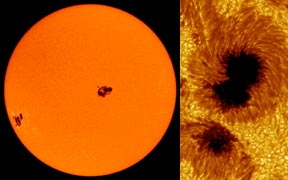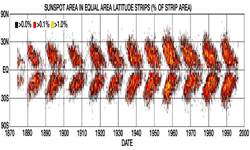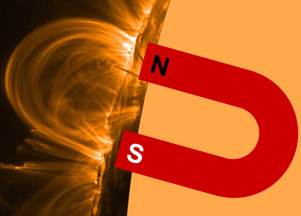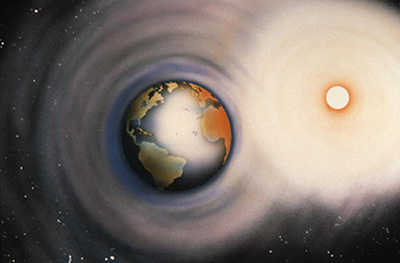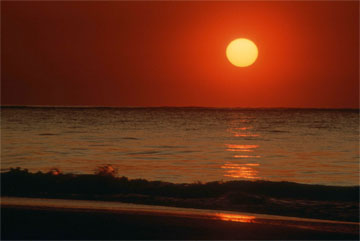Click on image for full size
NOAA/NGDC
Related links:
Movie: Magnetic Field Lines Tangle as Sun Rotates
Solar Cycle Variations and Effect on Earth's Climate
Sun's Effect on Earth's Weather
Video: Dark Days Ahead for the Sun (RealVideo courtesy of the National Science Foundation)
Solar Cycle
The number of sunspots on the Sun is not constant. In addition to the obvious variation caused by the Sun's rotation (sunspots disappear from view and then re-appear), over time new sunspot groups form and old ones decay and fade away. When viewed over short periods of time (a few weeks or months), this variation in the number of sunspots might seem to be random. However, observations over many years reveal a remarkable feature of the Sun: the number of sunspots varies in a periodic manner, usually described as the 11 year cycle (in actuality, the period varies, and has been closer to 10.5 years this century). The 11 year sunspot cycle is related to a 22 year cycle for the reversal of the Sun's magnetic field. In 1848 Johann Rudolf Wolf devised a method of counting sunspots on the solar disk called the Wolf number. Today the Wolf number (averaged from many observing sites) is used to keep track of the solar cycle. While the cycle has been relatively uniform this century, there have been large variations in the past. From about 1645 to 1715, a period known as the Maunder minimum, apparently few sunspots were present on the Sun. During the solar cycle,the migration of sunspots in latitude has a ``butterfly pattern.''
Although the number of sunspots is the most easily observed feature, essentially all aspects of the Sun and solar activity are influenced by the solar cycle. Because solar activity (such as coronal mass ejections) is more frequent at solar maximum and less frequent at solar minimum, geomagnetic activity also follows the solar cycle. Why is there a solar cycle? No one knows the answer to this question. A detailed explanation of the solar cycle is a fundamental physics problem still waiting to be solved.







